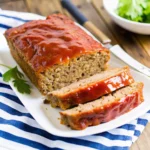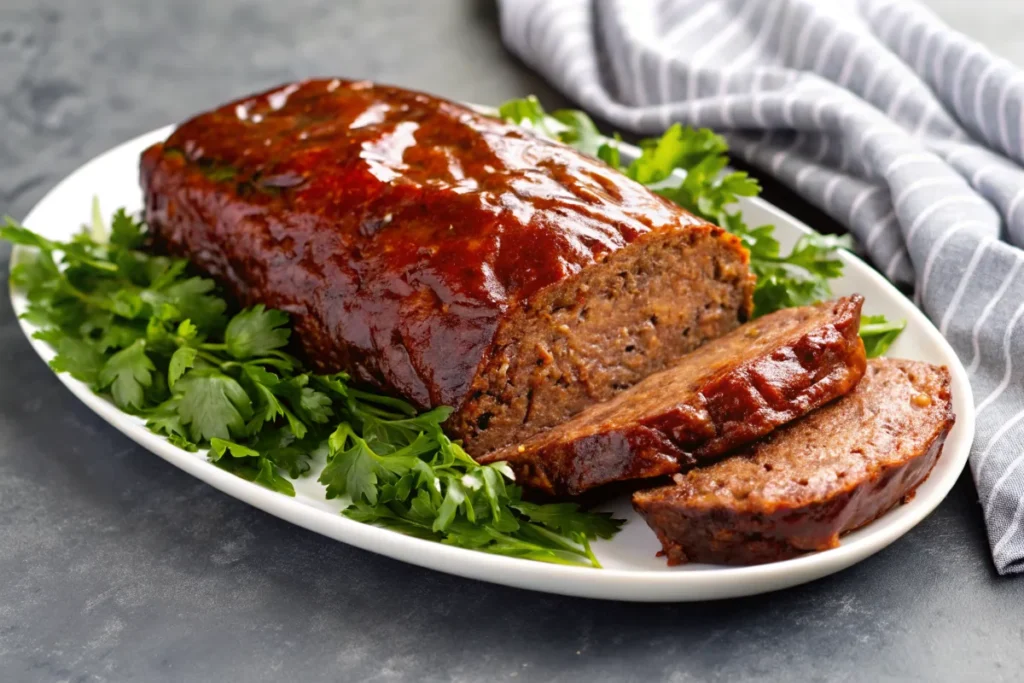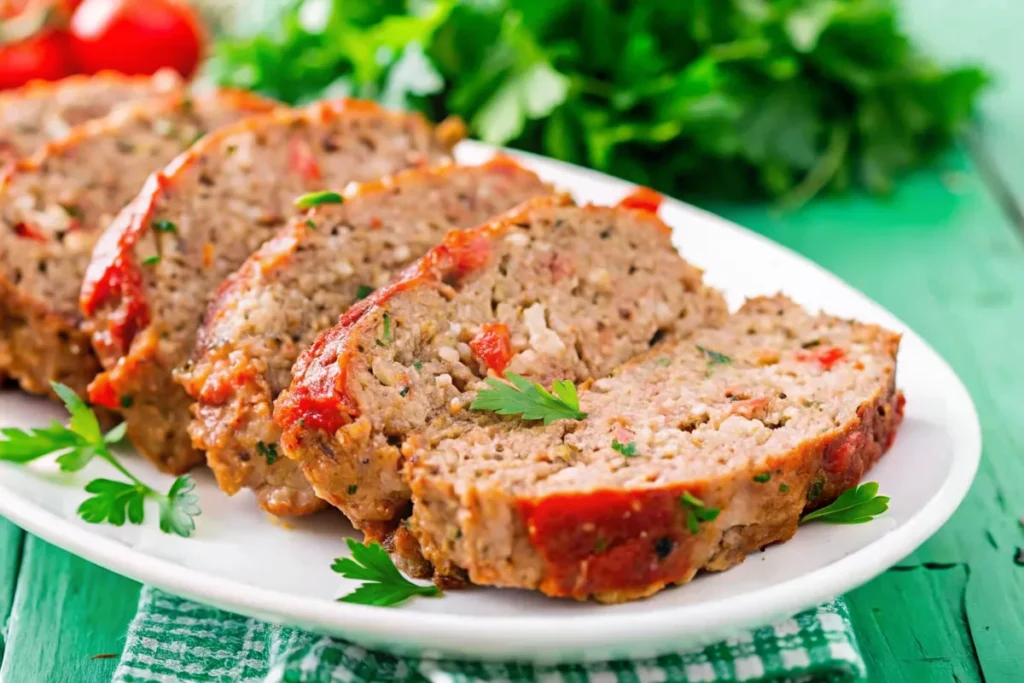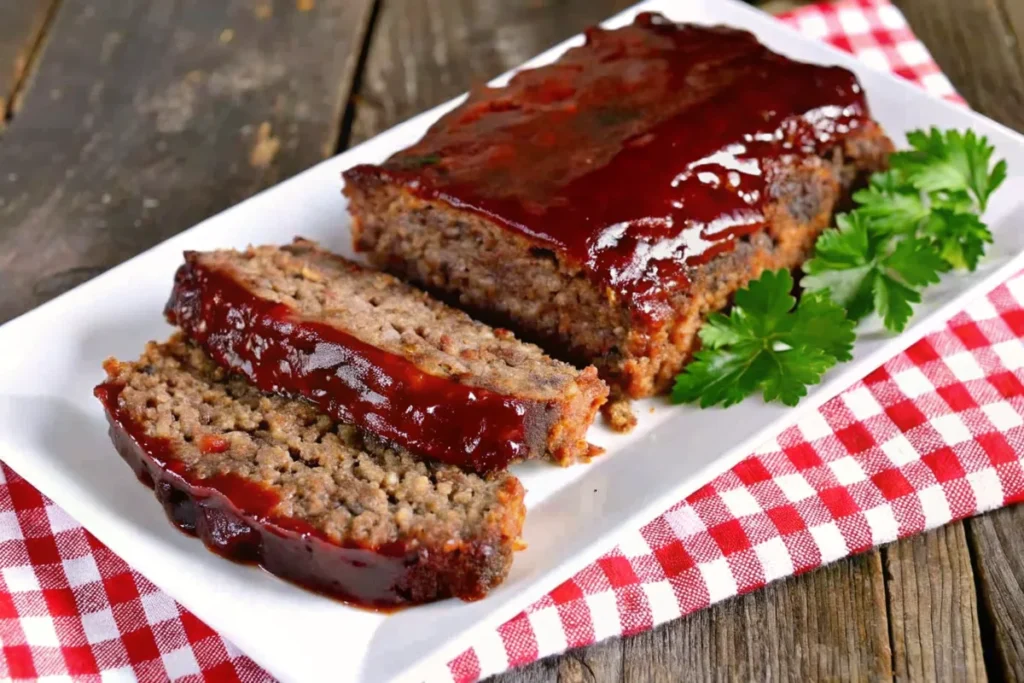Classic Meatloaf Recipe: Step by Step is your ultimate guide to mastering one of America’s most beloved comfort foods. Whether you grew up with Sunday meatloaf dinners or you’re trying it for the first time, this guide walks you through every stage of the process—from picking the right ingredients to serving it with perfect sides. We’ll show you how to create a moist, flavorful meatloaf with just the right texture, plus answer all your burning questions like why milk is added, what keeps it from crumbling, and how to boost the flavor.
This isn’t just another recipe—it’s the foundation of home cooking done right. We’ll break down everything with simple, easy-to-follow steps so anyone, at any level, can achieve meatloaf perfection. Whether you’re cooking for a crowd or planning meals for the week, classic meatloaf delivers comfort, tradition, and hearty satisfaction.
Print
Classic Meatloaf Recipe: Step by Step for the Perfect Comfort Food
- Total Time: 75 minutes
- Yield: 1 loaf (serves 6–8) 1x
Description
This Classic Meatloaf Recipe: Step by Step is your ultimate guide to one of America’s most beloved comfort foods. Juicy, tender, and full of savory flavor, this meatloaf combines pantry staples with simple techniques to deliver perfect results every time. Whether you’re recreating grandma’s dinner table or cooking meatloaf for the first time, this easy recipe ensures sliceable, moist meatloaf with a rich ketchup glaze—just the way it should be.
Ingredients
2 lbs ground beef (80/20 lean-to-fat ratio recommended)
1 cup plain breadcrumbs
1/2 cup milk
2 large eggs
1 small onion, finely chopped
2 cloves garlic, minced
1 tablespoon Worcestershire sauce
1 teaspoon salt
1/2 teaspoon black pepper
1/2 teaspoon garlic powder (optional)
1/2 teaspoon smoked paprika (optional)
For the glaze:
1/2 cup ketchup
1 tablespoon brown sugar
1 teaspoon white or apple cider vinegar
Instructions
Preheat the oven to 375°F (190°C). Line a baking sheet with parchment or lightly grease a loaf pan.
Soak the breadcrumbs in milk for 2–3 minutes in a large mixing bowl until softened.
Add the eggs, onion, garlic, Worcestershire sauce, salt, pepper, and any optional spices to the breadcrumb mixture. Mix well to combine.
Add the ground beef and gently mix with your hands until just combined. Avoid overmixing to keep the meatloaf tender.
Shape the mixture into a loaf, either on the prepared baking sheet or in a loaf pan.
Mix the glaze ingredients (ketchup, brown sugar, vinegar) in a small bowl, then spread over the top of the meatloaf.
Bake for 55–60 minutes, or until the internal temperature reaches 160°F (71°C).
Rest for 10 minutes before slicing. This helps lock in the juices and ensures clean cuts.
Notes
For extra moisture, try adding grated carrot or zucchini to the meat mixture.
For a flavor twist, substitute half the beef with ground pork or veal.
Storage Tips: Meatloaf can be refrigerated for up to 4 days or frozen in slices for up to 3 months. Reheat gently in the oven with a splash of broth for moisture.
Serving Suggestion: Pairs perfectly with mashed potatoes, green beans, or roasted carrots for a hearty comfort meal.
- Prep Time: 15 minutes
- Cook Time: 60 minutes
- Category: DINNER
- Method: Main Course
- Cuisine: American
Nutrition
- Serving Size: 1 slice (based on 8 slices)
- Calories: 330 per serving
- Sugar: ~5g
- Carbohydrates: ~14g
- Fiber: ~1g
- Protein: ~24g
Table of Contents
Understanding the Classic Meatloaf Recipe
What Makes a Meatloaf “Classic”?
A classic meatloaf recipe: step by step is all about simplicity, comfort, and consistency. What makes it classic isn’t just the ingredients—it’s the timeless flavor and no-fuss preparation. A traditional meatloaf typically includes ground beef, breadcrumbs, eggs, milk, and onions, topped with a tangy ketchup glaze. These ingredients come together to create a rich, savory, and satisfying dish that works for any night of the week.
Unlike modern versions that experiment with everything from turkey to lentils, a classic meatloaf sticks to the basics. The goal is a juicy, tender interior with a lightly crisp outer crust. It should hold its shape, slice cleanly, and taste just like mom or grandma used to make. And that’s the charm—it’s home-cooked nostalgia on a plate.
The Historical Roots of Traditional Meatloaf
The classic meatloaf we know today has humble roots. While the concept of mixing meat with grains goes back to ancient Roman times, America adopted and adapted it during the Great Depression. With meat prices high and families needing to stretch what they had, adding bread, oats, or crackers to ground beef became a practical solution.
In the post-WWII era, meatloaf soared in popularity, especially with the rise of packaged breadcrumbs and meat grinders in home kitchens. Cookbooks featured meatloaf as a go-to recipe for busy families. It was affordable, filling, and easy to prep ahead.
Today, meatloaf is more than just a budget meal—it’s a symbol of comfort. No longer just a pantry-saver, it’s been embraced by chefs and home cooks alike as the ultimate dinner table staple.
Key Ingredients in a Classic Meatloaf
What is in Traditional Meatloaf?
This is one of the most frequently asked questions—and for good reason. The basic ingredients in a classic meatloaf recipe are accessible and affordable. Here’s what you’ll need:
| Ingredient | Purpose |
|---|---|
| Ground beef | The protein base—80/20 is ideal for moisture |
| Breadcrumbs | Binds the meat and soaks up flavor |
| Eggs | Help hold the loaf together |
| Milk | Adds moisture and softens breadcrumbs |
| Onion | Brings sweetness and aromatic depth |
| Garlic | Adds flavor punch |
| Worcestershire | Boosts umami and richness |
| Salt & pepper | Essential seasoning |
| Ketchup (for glaze) | Adds sweetness and tangy top-layer |
Each component has a role. The breadcrumbs and milk combo is crucial—they soak together to create a tender binder that prevents your loaf from drying out or falling apart.
Discover great ideas like our baked chicken recipes if you’re planning a full week of comfort meals.
Must-Have Pantry Staples for the Recipe
If you keep a stocked pantry, chances are you already have most of what you need for a classic meatloaf. Still, a few key additions can make a big difference:
- Onion powder (if you don’t have fresh onions)
- Smoked paprika for added depth
- Beef bouillon granules for rich umami flavor
- Dijon mustard to cut through the richness
Pro tip: Always taste a tiny bit of your mixture by frying a small piece in a skillet before baking the full loaf. That way, you can adjust seasoning before it’s too late.

The Basic Meatloaf Formula Explained
What is the Basic Meatloaf Formula?
The classic meatloaf recipe: step by step approach begins with understanding the foundational formula behind every great loaf. While there’s some flexibility, a reliable ratio keeps your meatloaf from turning into a dry brick or a mushy mess.
Here’s the go-to formula:
- 2 lbs ground beef
- 1 cup breadcrumbs
- 2 large eggs
- 1/2 cup milk
- 1 small onion, finely chopped
- 2–3 tsp seasoning (salt, pepper, garlic, etc.)
This 2:1:1 ratio of meat to binder to moisture gives structure and flavor without overwhelming the meat. The eggs act as a binder, while milk softens the breadcrumbs to keep the meatloaf juicy and light.
Depending on your preference, you can tweak it slightly—more onion for sweetness, an extra egg for firmness, or panko instead of regular breadcrumbs for added texture.
Looking for inspiration? Try our egg bite recipe for other protein-packed kitchen staples.
Ratio of Meat, Binder, and Moisture – Why It Matters
Getting this ratio right is the real secret behind a perfect meatloaf. Too many breadcrumbs and your loaf will taste like stuffing. Too few, and it won’t hold together. Add too much milk and the mixture gets soggy, but skip it and the meat will dry out.
Best meatloaf ratio breakdown:
| Component | Amount | Role |
|---|---|---|
| Ground beef | 2 lbs | Flavor & structure |
| Breadcrumbs | 1 cup | Binds ingredients |
| Milk | 1/2 cup | Moisture retention |
| Eggs | 2 large | Firmness & cohesion |
Stick with this balance and you’re 90% of the way to meatloaf greatness.
Step-by-Step Instructions for the Best Classic Meatloaf
Prepping Your Ingredients Like a Pro
Start by gathering all your ingredients and prepping your workspace. Chop the onion finely so it cooks evenly and doesn’t leave crunchy bits in your meatloaf. Let the breadcrumbs soak in milk for 2–3 minutes to create a light, fluffy binder. This makes a huge difference in texture.
Pro tip:
If you like a stronger flavor profile, sauté the onions in a bit of olive oil until translucent before adding them to the meat mixture. It adds sweetness and a deeper aroma.
Mix your seasonings ahead of time (salt, pepper, garlic powder, maybe a bit of smoked paprika or parsley) to ensure even distribution.
Don’t skip our banana pancakes recipe for a sweet and simple breakfast pairing.
Mixing, Shaping & Baking the Meatloaf
Now comes the fun part—building your loaf.
Step-by-step Classic Meatloaf Method:
- Combine soaked breadcrumbs, eggs, onions, seasoning, and milk in a large bowl.
- Add ground beef last and mix gently with your hands. Overmixing = tough meatloaf.
- Shape the meat mixture into a loaf—either in a loaf pan or freeform on a lined baking sheet.
- Top with a layer of ketchup or a simple glaze (ketchup + brown sugar + a splash of vinegar).
- Bake at 375°F for about 55–60 minutes. Internal temp should reach 160°F.
- Rest for 10 minutes before slicing. This locks in juices and keeps it from falling apart.
Here’s a table for quick reference:
| Step | Action |
|---|---|
| 1. Combine | Breadcrumbs, eggs, milk, onion, seasonings |
| 2. Mix | Add ground beef, fold gently |
| 3. Shape | Into a loaf on parchment or in a pan |
| 4. Glaze | Apply ketchup or custom topping |
| 5. Bake | 375°F for 55–60 min |
| 6. Rest | 10 min before slicing |
Don’t skip resting time—it’s a game-changer!

The Secret to a Great Meatloaf
What is the Secret to a Great Meatloaf?
Ask any seasoned home cook, and they’ll tell you: the secret to a great classic meatloaf recipe: step by step lies in texture, moisture, and flavor balance. It’s not just about tossing meat and breadcrumbs together. A great loaf holds together, slices beautifully, and explodes with flavor in every bite.
Here are the pro secrets that separate good from unforgettable meatloaf:
- Don’t overmix the meat. Overworking the meat can make your loaf dense and rubbery. Mix just enough to combine the ingredients.
- Soak your binder. Mixing breadcrumbs with milk (or broth) before combining adds moisture and improves texture.
- Use a mix of meats. For enhanced depth, try blending ground beef with pork or veal. It mimics a butcher’s blend and boosts flavor.
- Balance seasoning. Garlic, onion, salt, pepper, and Worcestershire sauce are musts—but don’t go overboard.
For a flavorful finish, glaze the top with a mixture of ketchup, brown sugar, and a splash of vinegar or mustard. This creates that sweet-savory crust that makes every slice irresistible.
Tips from Grandma’s Kitchen That Still Work Today
Grandma always knew how to make homestyle meatloaf that turned heads—and plates. Here are timeless tips that still hold up:
- Use fresh ingredients: Fresh onion and garlic beat powders every time.
- Let it rest: After baking, let your meatloaf sit for 10 minutes. This helps juices settle and prevents crumbling.
- Test seasoning: Before baking the whole loaf, fry a small meatball-size piece to test your seasoning level.
- Add umami boosters: A dash of soy sauce, grated Parmesan, or tomato paste can deepen flavor without overpowering the dish.
Want a cozy main dish to serve with meatloaf? Discover great ideas like our baked chicken recipes.
Preventing a Dry or Crumbly Meatloaf
What Ingredient Keeps Meatloaf from Falling Apart?
A question we get all the time is: What keeps meatloaf from falling apart? The answer is simple—binders and balance. In a classic meatloaf recipe: step by step, your main binders are eggs and breadcrumbs, but the real trick is soaking the breadcrumbs in milk.
When breadcrumbs are moistened, they act like a sponge, keeping everything together while also locking in flavor and moisture. Eggs add structure, making sure your meatloaf stays sliceable and doesn’t fall apart on the plate.
If your meatloaf crumbles when cut, here’s why:
- Not enough binder (breadcrumbs and eggs)
- No moisture balance (too little milk or onion)
- Overbaking or skipping the resting time
Tips to Achieve a Moist, Juicy Texture Every Time
Learning how to keep meatloaf moist is what turns a decent recipe into a legendary one. Here’s how:
- Use the right meat: An 80/20 ground beef ratio is ideal. Too lean, and it’ll dry out.
- Add moisture-rich ingredients: Grated onion, soaked breadcrumbs, and even shredded zucchini or carrot add hydration.
- Bake uncovered: But tent with foil toward the end if it starts to brown too much.
- Avoid overcooking: Use a meat thermometer. Pull at 160°F, and let it rest.
| Moisture Booster | How It Helps |
|---|---|
| Milk | Softens breadcrumbs, adds tenderness |
| Grated onion | Releases juices into the mix |
| Eggs | Binds and traps moisture |
| Ketchup glaze | Seals top, preventing dryness |
If your meatloaf is falling apart, it’s usually not about technique—it’s about ratios. Follow the classic meatloaf recipe: step by step and you’ll nail the texture every time.
Enhancing Flavor: Classic & Modern Twists
What Gives Meatloaf the Best Flavor?
If you’ve followed a classic meatloaf recipe: step by step and still feel like it needs a little extra something—you’re not alone. Flavor is the soul of meatloaf, and even traditional versions leave room for personal flair.
To give your meatloaf the best flavor, start with bold basics: garlic, onion, salt, pepper, and Worcestershire sauce. These build a solid foundation of savory goodness. But if you’re ready to turn it up a notch, consider these pro-level flavor boosters:
- Fresh herbs like parsley, thyme, or rosemary
- Tomato paste or Dijon mustard for tang and depth
- Grated Parmesan cheese for a salty, umami-rich punch
- Smoked paprika or cayenne for a subtle kick
One of the benefits of following a classic meatloaf recipe: step by step is that once you’ve mastered the core, it’s easy to experiment with added layers of flavor. You can fold in shredded cheese, chopped bell peppers, or even bacon without compromising the meatloaf’s structure.
Still sticking to the traditional? That’s great too—just be sure to season each layer: the meat, the glaze, and even the binder mix. It all adds up to a rich, complex bite.
Flavor Boosters: Spices, Herbs, and Add-ins You’ll Love
Take your classic meatloaf recipe: step by step further by adding fresh or dry herbs and simple pantry staples. Here’s a flavor-boosting cheat sheet:
| Ingredient | Flavor Impact |
|---|---|
| Fresh garlic | Sharp, savory punch |
| Thyme or rosemary | Earthy depth |
| Tomato paste | Concentrated umami and richness |
| Worcestershire sauce | Smoky, tangy boost |
| Dijon mustard | Acidic, spicy brightness |
When you enhance flavor the right way, your guests will never ask for ketchup again.
Looking for bold ideas? Check out our garlic butter steak bites potatoes for side dish inspiration that won’t be outshined.
Why Milk is Essential in Meatloaf
Why Do You Put Milk in Meatloaf?
Many first-time cooks wonder: Why milk? The answer is simple—milk unlocks moisture and tenderness in every bite. In the classic meatloaf recipe: step by step, milk is used to soak the breadcrumbs before they’re mixed into the meat. This soaking process transforms the breadcrumbs into a soft binder that holds the loaf together without drying it out.
Skipping the milk or using too little can result in a dense, tough texture. Using too much can make it soggy. The key is moderation—about 1/2 cup of milk per 2 pounds of meat, just as the classic meatloaf recipe: step by step instructs.
Milk doesn’t just moisten the meatloaf—it disperses flavors more evenly and gives the loaf a tender, melt-in-your-mouth feel. For those avoiding dairy, low-sodium broth or unsweetened almond milk are solid substitutes that maintain texture without compromising flavor.
This step might seem small, but it’s a big deal. The difference between a good loaf and a great one often comes down to how well the breadcrumbs are hydrated.
Alternatives to Milk for Dairy-Free Cooks
If you’re dairy-free or simply out of milk, don’t panic. The classic meatloaf recipe: step by step can easily be adapted with alternatives that provide the same moisture and consistency. Here are a few substitutions that work like a charm:
- Beef or chicken broth: Adds both moisture and flavor
- Unsweetened almond or oat milk: Keeps the binder soft
- Greek yogurt or sour cream (for a tangy twist)
- Water with a splash of olive oil
| Milk Alternative | Best For |
|---|---|
| Chicken/beef broth | Savory, umami-forward meatloaf |
| Almond milk | Neutral taste, light texture |
| Yogurt or sour cream | Richness and tang |
Whatever option you choose, the goal remains the same: keeping your classic meatloaf recipe: step by step moist, flavorful, and structurally sound.
PART 9: Serving, Storing & Reheating
Best Side Dishes to Serve with Meatloaf
Once you’ve mastered the classic meatloaf recipe: step by step, it’s time to complete the meal with perfect pairings. The beauty of meatloaf is its versatility—it pairs beautifully with comforting sides, crisp veggies, or even something a little unexpected.
Here are some all-time favorites to serve with meatloaf:
- Mashed potatoes with butter and garlic
- Green beans sautéed in olive oil and lemon
- Roasted carrots with honey glaze
- Mac and cheese for full-on comfort
- Buttered corn with black pepper
- Simple garden salad for balance
A great rule of thumb? Mix a hearty carb with something light and green. The rich, savory profile of the meatloaf shines brightest when surrounded by complementary textures and flavors.
If you’ve followed the classic meatloaf recipe: step by step to the letter, these sides will elevate the experience from “just dinner” to “dinner to remember.”
How to Store, Freeze, and Reheat Without Losing Flavor
Storing leftovers the right way ensures you’ll enjoy the same great taste even days later. Whether you’re planning ahead or simply had more than expected, here’s how to make it last.
Refrigeration:
- Let meatloaf cool completely before storing.
- Wrap tightly in foil or place in an airtight container.
- Keeps fresh for up to 4 days in the fridge.
Freezing:
- Slice before freezing for easy portion control.
- Wrap individual slices in plastic wrap and foil.
- Store in freezer-safe bags or containers for up to 3 months.
Reheating:
- Oven method: Wrap in foil and bake at 300°F for 15–20 minutes.
- Microwave: Use medium power and cover to keep moisture in.
- Add a splash of broth or water before reheating to revive moisture.
When you use the classic meatloaf recipe: step by step, your meatloaf is already optimized for flavor and structure—which makes reheating smoother and tastier.

Frequently Asked Questions (FAQs)
These answers are crafted based on the most commonly searched questions—delivered in simple, helpful language to support every step of your cooking journey.
What is in traditional meatloaf?
A traditional meatloaf includes ground beef, breadcrumbs, eggs, milk, onion, garlic, and seasonings like salt, pepper, and Worcestershire sauce. It’s finished with a tangy ketchup glaze baked on top. These ingredients are what give the classic meatloaf recipe: step by step its familiar, comforting taste.
What is the basic meatloaf formula?
The basic formula is simple: 2 pounds of ground beef, 1 cup of breadcrumbs, 2 eggs, and 1/2 cup of milk. This ratio creates the perfect blend of moisture, structure, and flavor—just like the classic meatloaf recipe: step by step recommends.
What is the secret to a great meatloaf?
The secret lies in balanced seasoning, using a soaked breadcrumb binder, and avoiding overmixing the meat. Letting the meatloaf rest before slicing also ensures juicy results. Follow the classic meatloaf recipe: step by step, and you’re set up for success.
What ingredient keeps meatloaf from falling apart?
Eggs and breadcrumbs are essential for binding. Milk-softened breadcrumbs help everything hold together while staying moist. This is a crucial part of the classic meatloaf recipe: step by step process.
What gives meatloaf the best flavor?
Flavor comes from layers: onion, garlic, herbs, Worcestershire sauce, and the glaze. Adding extras like mustard or cheese can amplify the flavor, but sticking with the classic meatloaf recipe: step by step will always give you a rich, satisfying result.
Why do you put milk in meatloaf?
Milk hydrates the breadcrumbs, helping create a tender texture and locking in moisture. Without it, the meatloaf can be dry. It’s a small but essential step in the classic meatloaf recipe: step by step approach.
Conclusion
There’s a reason the classic meatloaf recipe: step by step remains a beloved staple in so many kitchens—it’s reliable, comforting, and downright delicious. Whether you’re feeding a hungry family or prepping meals for the week, this dish delivers hearty flavor with minimal fuss. By focusing on the right balance of ingredients, proper technique, and a few tried-and-true secrets, you’ve got everything you need to make your meatloaf a standout.
From understanding why milk matters to preventing crumbling, this classic meatloaf recipe: step by step has guided you through every detail. We’ve covered the core formula, flavor enhancements, and the best ways to store and serve it.
Remember, the magic lies in the simplicity. By mastering the classic meatloaf recipe: step by step, you’re not just making dinner—you’re creating comfort, connection, and tradition that stands the test of time.
